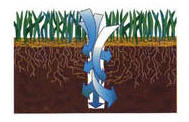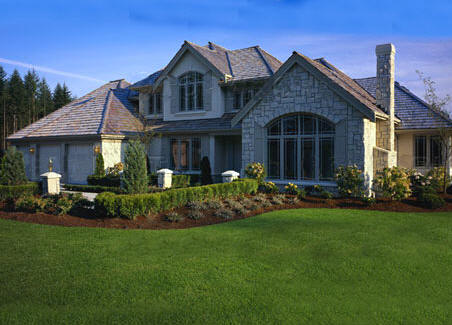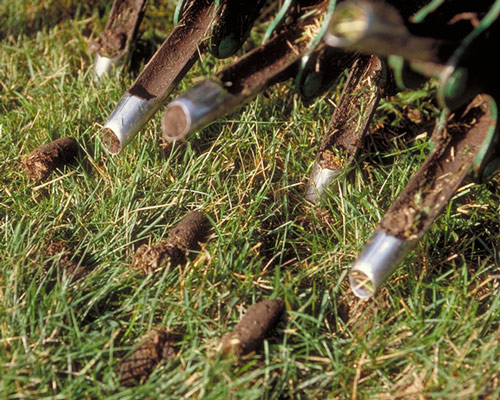What are the benefits of Aeration?
Core aeration can help make your lawn healthier and reduce
its maintenance requirements through these means:
- Improved air exchange between soil and atmosphere.
- Enhanced soil water uptake.
- Improved fertilizer uptake and use.
- Reduced water runoff and puddling.
- Stronger turfgrass roots.
- Reduced soil compaction.
- Enhanced heat and drought stress tolerance.
- Improved resiliency and cushioning.
- Enhanced thatch breakdown.
Equipment Affects the Outcome
The type of aeration equipment can determine how
effective the treatment will be. In general, turf responds best
when core holes are close and deep. Equipment with open tines
divots the soil surface. Aeration equipment also varies in tine
size up to 3/4 inch diameter and in depth penetration up to 4
inches, depending on the manufacturer's specifications.
Why is Aeration Necessary?
In most newer housing developments, the fertile
topsoil may have been removed or buried during excavation of the
foundation and basement. This then forces the grass to grow in
subsoil that is more compact,
higher in clay content and less likely to sustain a healthy
lawn. |
Walking, playing and mowing will compact soil
and stress lawns. Raindrops and irrigation further compact the
soil, reducing large air spaces where roots readily grow.
Compaction is greater on heavy clay soils than on sandy soils,
and it is greatest in the upper 1 to 1 1/2 inches of soil.
Aeration can help relieve soil compaction,
allowing your grass to grow deeper roots and make better use of
water and fertilizer.

ROOT GROWTH
Core aeration allows air, water and fertilizer
to better reach the root zone. This stimulates root growth to
create healthier, stronger turf grass plants.
Relieve Thatch Accumulation
Core aeration mechanically removes soil plugs
and deposits them on top of the existing grass and thatch
layer. This action brings soil organisms further up to start
breaking down the thatch layer and reduce it's accumulation. |
How Often Should Lawns Be Aerated?
All lawns benefit from annual aeration. Heavily
used lawns, or those growing on heavy clay or subsoils may need
more than one aeration each year. Again, turf responds best when
tine spacing it closer and penetration is deeper.
When is the Best Time to Aerate?
If you have cool season turf grasses such as
Kentucky Bluegrass, Perennial Ryegrass, or Fine Fescue, spring
and fall aeration are both good. Fall aeration however is the
best time, before the final fertilizing for the year. Fall
aeration will also have much less weed break through than
aerating in the spring.
Warm season turfgrasses such as zoysiagrass and
bermudagrass should be aerated in mid-spring to summer. Avoid
aerating when warm season grasses are dormant - it may encourage
weed competition. In addition, avoid aerating warm season
grasses during spring greenup, and not until after their first
spring mowing.
Herbicides, Fertilizers & Aeration
It's best to aerate before you apply
pre-emergence herbicides, rather than after. Aerating after a
herbicide application can reduce the chemical barrier formed by
the herbicide, allowing weeds to germinate. Applying fertilizer
after aeration helps the lawn compete against weeds. Water the
lawn after aeration, particularly in areas where drought and
high temperatures are common. |



